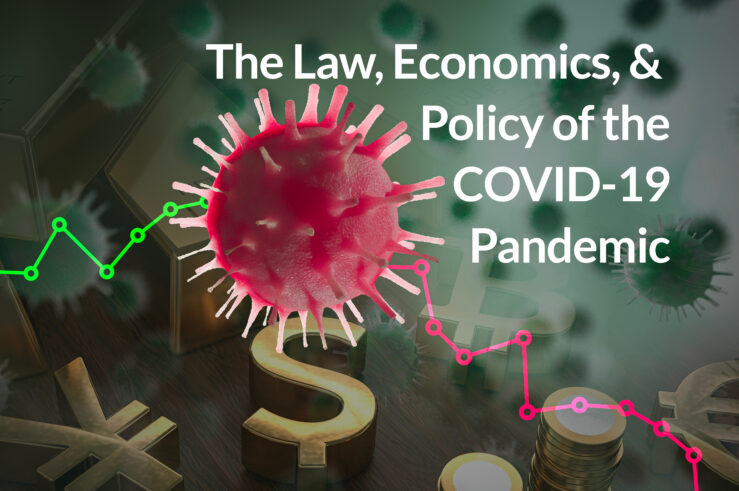
This article is a part of the The Law, Economics, and Policy of the COVID-19 Pandemic symposium.

[TOTM: The following is part of a blog series by TOTM guests and authors on the law, economics, and policy of the ongoing COVID-19 pandemic. The entire series of posts is available here.
This post is authored by Tim Brennan, (Professor, Economics & Public Policy, University of Maryland; former FCC; former FTC).]
Thinking about how to think about the coronavirus situation I keep coming back to three economic ideas that seem distinct but end up being related. First, a back of the envelope calculation suggests shutting down the economy for a while to reduce the spread of Covid-19. This leads to my second point, that political viability, if not simple fairness, dictates that the winners compensate the losers. The extent of both of these forces my main point, to understand why we can’t just “get the prices right” and let the market take care of it. Insisting that the market works in this situation could undercut the very strong arguments for why we should defer to markets in the vast majority of circumstances.
Is taking action worth it?
The first question is whether shutting down the economy to reduce the spread of Covid-19 is a good bet. Being an economist, I turn to benefit-cost analysis (BCA). All I can offer here is a back-of-the-envelope calculation, which may be an insult to envelopes. (This paper has a more serious calculation with qualitatively similar findings.) With all caveats recognized, the willingness to pay of an average person in the US to social distancing and closure policies, WTP, is
WTP = X% times Y% times VSL,
where X% is the fraction of the population that might be seriously affected, Y% is the reduction in the likelihood of death for this population from these policies, and VSL is the “value of statistical life” used in BCA calculations, in the ballpark of $9.5M.
For X%, take the percentage of the population over 65 (a demographic including me). This is around 16%. I’m not an epidemiologist, so for Y%, the reduced likelihood of death (either from reduced transmission or reduced hospital overload), I can only speculate. Say it’s 1%, which naively seems pretty small. Even with that, the average willingness to pay would be
WTP = 16% times 1% times $9.5M = $15,200.
Multiply that by a US population of roughly 330M gives a total national WTP of just over $5 trillion, or about 23% of GDP. Using conventional measures, this looks like a good trade in an aggregate benefit-cost sense, even leaving out willingness to pay to reduce the likelihood of feeling sick and the benefits to those younger than 65. Of course, among the caveats is not just whether to impose distancing and closures, but how long to have them (number of weeks), how severe they should be (gathering size limits, coverage of commercial establishments), and where they should be imposed (closing schools, colleges).
Actual, not just hypothetical, compensation
The justification for using BCA is that the winners could compensate the losers. In the coronavirus setting, the equity considerations are profound. Especially when I remember that GDP is not a measure of consumer surplus, I ask myself how many months of the disruption (and not just lost wages) from unemployment should low-income waiters, cab drivers, hotel cleaners, and the like bear to reduce my over-65 likelihood of dying.
Consequently, an important component of this policy to respect equity and quite possibly obtaining public acceptance is that the losers be compensated. In that respect, the justification for packages such as the proposal working (as I write) through Congress is not stimulus—after all, it’s harder to spend money these days—as much as compensating those who’ve lost jobs as a result of this policy. Stimulus can come when the economy is ready to be jump-started.
Markets don’t always work, perhaps like now
This brings me to a final point—why is this a public policy matter? My answer to almost any policy question is the glib “just get the prices right and the market will take care of it.” That doesn’t seem all that popular now. Part of that is the politics of fairness: Should the wealthy get the ventilators? Should hoarding of hand sanitizer be rewarded? But much of it may be a useful reminder that markets do not work seamlessly and instantaneously, and may not be the best allocation mechanism in critical times.
That markets are not always best should be a familiar theme to TOTM readers. The cost of using markets is the centerpiece for Ronald Coase’s 1937 Nature of the Firm and 1960 Problem of Social Cost justification for allocation through the courts. Many of us, including me on TOTM, have invoked these arguments to argue against public interventions in the structure of firms, particularly antitrust actions regarding vertical integration. Another common theme is that the common law tends toward efficiency because of the market-like evolutionary processes in property, tort, and contract case law.
This perspective is a useful reminder that the benefits of markets should always be “compared to what?” In one familiar case, the benefits of markets are clear when compared to the snail’s pace, limited information, and political manipulability of administrative price setting. But when one is talking about national emergencies and the inelastic demands, distributional consequences, and the lack of time for the price mechanism to work its wonders, one can understand and justify the use of the plethora of mandates currently imposed or contemplated.
The common law also appears not to be a good alternative. One can imagine the litigation nightmare if everyone who got the virus attempted to identify and sue some defendant for damages. A similar nightmare awaits if courts were tasked with determning how the risk of a pandemic would have been allocated were contracts ideal.
Much of this may be belaboring the obvious. My concern is that if those of us who appreciate the virtues of markets exaggerate their applicability, those skeptical of markets may use this episode to say that markets inherently fail and more of the economy should be publicly administered. Better to rely on facts rather than ideology, and to regard the current situation as the awful but justifiable exception that proves the general rule.




